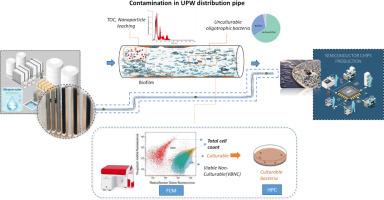Biostability assessment of ultrapure water piping materials in the semiconductor industry and their susceptibility to Ralstonia growth
IF 8.3
1区 工程技术
Q1 ENGINEERING, CHEMICAL
引用次数: 0
Abstract
The pipes used for ultrapure water (UPW) distribution are constructed using high-quality materials to ensure purity. However, there remains a risk of contamination based on the pipe type. This study is the first to comprehensively evaluate the biological implications of various UPW pipe materials used in the semiconductor industry. The results showed that Polyvinylidene fluoride (PVDF) exhibited lower organic carbon leaching (0.08 mg/L) and a reduced biomass formation potential (BFP) (approximately 5 × 105 cells/cm2) compared to chlorinated polyvinyl chloride (CPVC) pipes. In particular, Ralstonia, an oligotrophic bacterium commonly found in UPW systems, formed a significant biofilm on pipe surfaces, notably in stainless steel (SUS) and CPVC pipes. Furthermore, particle contamination, a critical concern in semiconductor manufacturing, was investigated, focusing on potential contamination sources generated by pipe leaching and the presence of bacteria. The bacterial composition of the selected UPW was investigated, revealing Herbaspirillum, a nitrogen-fixing bacterium, as the dominant species, account for 66.15 %. Notably, the composition of the feedwater was different from that of the UPW. This study also highlights the limitations of culture-based methods, particularly in detecting bacteria under oligotrophic conditions, which are often unculturable. Flow cytometry (FCM) shows promise for the quick detection of bacterial contamination by providing total cell counts. Moreover, cytometric fingerprinting analysis revealed phenotypic differences between the communities. Nevertheless, further development of a simplified and widely applicable cell counting protocol is required for its effective integration into UPW production.

半导体工业超纯水管道材料的生物稳定性评估及其对 Ralstonia 生长的易感性
用于超纯水(UPW)输送的管道采用优质材料制成,以确保纯度。然而,根据管道类型的不同,仍存在污染风险。本研究首次全面评估了半导体行业使用的各种超纯水管道材料对生物的影响。结果显示,与氯化聚氯乙烯(CPVC)管道相比,聚偏二氟乙烯(PVDF)的有机碳浸出率(0.08 mg/L)较低,生物量形成潜能(BFP)也有所降低(约为 5 × 105 个细胞/cm2)。特别是,在 UPW 系统中常见的低营养细菌 Ralstonia 在管道表面形成了大量生物膜,尤其是在不锈钢(SUS)和 CPVC 管道中。此外,还对半导体制造过程中的关键问题--微粒污染进行了调查,重点是管道沥滤产生的潜在污染源和细菌的存在。对所选 UPW 的细菌组成进行了调查,结果显示固氮菌 Herbaspirillum 是主要菌种,占 66.15%。值得注意的是,给水的成分与 UPW 的成分不同。这项研究还凸显了基于培养的方法的局限性,尤其是在检测寡营养条件下的细菌时,因为这些细菌通常无法培养。流式细胞仪 (FCM) 通过提供细胞总数,为快速检测细菌污染带来了希望。此外,细胞指纹分析还揭示了群落之间的表型差异。不过,还需要进一步开发简化且广泛适用的细胞计数方案,以便将其有效整合到 UPW 生产中。
本文章由计算机程序翻译,如有差异,请以英文原文为准。
求助全文
约1分钟内获得全文
求助全文
来源期刊

Desalination
工程技术-工程:化工
CiteScore
14.60
自引率
20.20%
发文量
619
审稿时长
41 days
期刊介绍:
Desalination is a scholarly journal that focuses on the field of desalination materials, processes, and associated technologies. It encompasses a wide range of disciplines and aims to publish exceptional papers in this area.
The journal invites submissions that explicitly revolve around water desalting and its applications to various sources such as seawater, groundwater, and wastewater. It particularly encourages research on diverse desalination methods including thermal, membrane, sorption, and hybrid processes.
By providing a platform for innovative studies, Desalination aims to advance the understanding and development of desalination technologies, promoting sustainable solutions for water scarcity challenges.
 求助内容:
求助内容: 应助结果提醒方式:
应助结果提醒方式:


